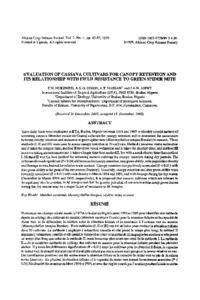| dc.contributor.author | Nukenine, E.N. |
| dc.contributor.author | Dixon, Alfred G.O. |
| dc.contributor.author | Hassan, A.T. |
| dc.contributor.author | Asiwe, J.A.N. |
| dc.date.accessioned | 2019-12-04T11:23:37Z |
| dc.date.available | 2019-12-04T11:23:37Z |
| dc.date.issued | 1999 |
| dc.identifier.citation | Nukenine, E.N., Dixon, A.G.O., Hassan, A.T. & Asiwe, J.A.N. (1999). Evaluation of cassava cultivars for canopy retention and its relationship with field resistance to green spider mite. African Crop Science Journal, 7(1), 47-57. |
| dc.identifier.issn | 1021-9730 |
| dc.identifier.uri | https://hdl.handle.net/20.500.12478/4069 |
| dc.description.abstract | Three field trials were conducted at IITA, Ibadan, Nigeria between 1993 and 1995 to identify a rapid method of screening cassava (Manihot esculenta Crantz) cultivars for canopy retention and to determine the association between canopy retention and resistance to green spider mite (Mononychellus tanajoa Bondar) in cassava. Three methods (I, II and III) were used to assess canopy retention in 70 cultivars. Method I involves visual estimation and it takes the longest time; method II involves visual estimation and it takes the shortest time; and method III involves taking measurements and it takes a longer time than method II, but with a much shorter time than method I. Method II was the best method for screening cassava cultivars for canopy retention during dry periods. The cultivars showed significant (P < 0.01) differences for canopy retention, stay green ability, mite population density and damage scores, but not for relative water content. Canopy retention was positively correlated (P < 0.01) with stay green ability at the peak of the dry season (January). Generally, canopy retention and stay green ability were inversely associated (P < 0.01) with mite density in March 1994 and 1995, and with damage during the dry season (December to March 1994 and 1995, respectively). It is proposed that cassava cultivars which are tolerant to drought may also be resistant to M. tanajoa and that the genetic potential of cassava to retain many green leaves during the dry season may be a major factor of resistance to M. tanajoa. |
| dc.language.iso | en |
| dc.subject | Manihot Esculenta |
| dc.subject | Mononychellus Tanajoa |
| dc.subject | Relative Humidity |
| dc.subject | Cassava |
| dc.subject | Spider Mites |
| dc.title | Evaluation of cassava cultivars for canopy retention and its relationship with field resistance to green spider mite |
| dc.type | Journal Article |
| dc.description.version | Peer Review |
| cg.contributor.crp | Roots, Tubers and Bananas |
| cg.contributor.affiliation | International Institute of Tropical Agriculture |
| cg.contributor.affiliation | University of Ibadan |
| cg.contributor.affiliation | Université de Ngaoundéré |
| cg.coverage.region | Africa |
| cg.coverage.region | West Africa |
| cg.coverage.country | Nigeria |
| cg.isijournal | ISI Journal |
| cg.authorship.types | CGIAR and developing country institute |
| cg.iitasubject | Cassava |
| cg.iitasubject | Farming Systems |
| cg.accessibilitystatus | Limited Access |
| local.dspaceid | 99355 |

